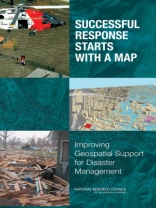In the past few years the United States has experienced a series of disasters, such as Hurricane Katrina in 2005, which have severely taxed and in many cases overwhelmed responding agencies. In all aspects of emergency management, geospatial data and tools have the potential to help save lives, limit damage, and reduce the costs of dealing with emergencies. Great strides have been made in the past four decades in the development of geospatial data and tools that describe locations of objects on the Earth’s surface and make it possible for anyone with access to the Internet to witness the magnitude of a disaster. However, the effectiveness of any technology is as much about the human systems in which it is embedded as about the technology itself. Successful Response Starts with a Map assesses the status of the use of geospatial data, tools, and infrastructure in disaster management, and recommends ways to increase and improve their use. This book explores emergency planning and response; how geospatial data and tools are currently being used in this field; the current policies that govern their use; various issues related to data accessibility and security; training; and funding. Successful Response Starts with a Map recommends significant investments be made in training of personnel, coordination among agencies, sharing of data and tools, planning and preparedness, and the tools themselves.
Board on Earth Sciences and Resources & Division on Earth and Life Studies
Successful Response Starts with a Map [EPUB ebook]
Improving Geospatial Support for Disaster Management
Successful Response Starts with a Map [EPUB ebook]
Improving Geospatial Support for Disaster Management
¡Compre este libro electrónico y obtenga 1 más GRATIS!
Idioma Inglés ● Formato EPUB ● Páginas 198 ● ISBN 9780309179119 ● Editorial National Academies Press ● Publicado 2006 ● Descargable 3 veces ● Divisa EUR ● ID 7142957 ● Protección de copia Adobe DRM
Requiere lector de ebook con capacidad DRM












